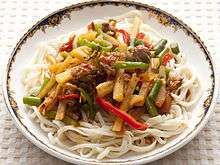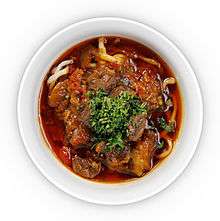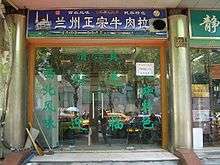Lamian
|
| |
| Type | Chinese noodles |
|---|---|
| Place of origin | China |
|
| |
| Lamian | |||||||||||||||||||||||
| Simplified Chinese | 拉面 | ||||||||||||||||||||||
|---|---|---|---|---|---|---|---|---|---|---|---|---|---|---|---|---|---|---|---|---|---|---|---|
| Traditional Chinese | 拉麵 | ||||||||||||||||||||||
| Hanyu Pinyin | lāmiàn | ||||||||||||||||||||||
| Literal meaning | pulled noodle | ||||||||||||||||||||||
| |||||||||||||||||||||||
Lamian is a type of Chinese noodle. Lamian is made by twisting, stretching and folding the dough into strands, using the weight of the dough.[1] The length and thickness of the strands depends on the number of times the dough is folded.[1] This unique method of making noodles originated in China.[1] The Songshi Yangsheng Bu (simplified Chinese: 宋氏养生部; traditional Chinese: 宋氏養生部), which was written by Song Xu and dates back to 1504, has the earliest description of the method to make lamian.[1]
Description
The hand-making process involves taking a lump of dough and repeatedly stretching it to produce many strands of thin, long noodle. Literally, lā, (拉) means to pull or stretch, while miàn (simplified: 面/traditional: 麵) means noodle.
There are several styles of twisting the dough but they all employ the same concept: a piece of dough is repeatedly stretched and folded onto itself in order to align the glutens and warm up the dough for stretching. Then it is rolled out to a workable thickness and cut into workable portions. The end pieces of the starting dough are never used because the glutens are not as aligned as the middle pieces.
This dough is then pulled to about an arm span's length. The puller then makes a loop with the dough, joining the two ends into one clump of dough, and inserts his fingers into the loop to keep the strand from sticking to itself. Doing this, the pull has doubled the length of the dough while fractioning its thickness. This process is repeated several times until the desired thickness and quantity is achieved. Some pullers dip the strands into flour between stretching phases to keep them separated. When flour is used, there generally is a final slap of noodles against the prep board to remove excess flour.
In the Lanzhou style, the dough is worked aggressively. It is pulled in straight, quick, tugs with no twisting or waving. Some pullers regularly slam the noodle against their prep boards to ensure even stretching and uniform thickness. Flour is sometimes used to dust the strands and prevent sticking.
In the Beijing style of preparation, the dough is twisted, stretched delicately by waving the arms and body, untwisted, looped to double the strands, and then repeated. When stretching, they coordinate waving their torso and arms to increase the potential length of the noodle beyond that of the puller's arm span. Flour dusting is more liberally employed in this style than in the Lanzhou style of preparation.
There is also another style, in which the noodle maker stretches one thick, flat strand of dough between two hands. This is usually done for show and involves the puller twirling and spinning much like Chinese ribbon dancing.
Use in dishes
Dishes using lamian are usually served in a beef or mutton-flavored soup called tāngmiàn (simplified Chinese: 汤面; traditional Chinese: 湯麵; pinyin: Tāngmiàn literally 'soup noodles'), but sometimes stir-fried and served with a sauce, this dish being called chǎomiàn (simplified Chinese: 炒面; traditional Chinese: 炒麵; pinyin: Chǎomiàn, literally 'fried noodles.' This word is etymologically related to chow mein though the dish itself is different).
Region
China
Small restaurants serving Lanzhou-style lamian are very common throughout western China where they have formed a staple diet for centuries, as well as eastern Chinese cities. They tend to serve a variety of low cost meals, with a choice of lamian, daoxiaomian (simplified Chinese: 刀削面; traditional Chinese: 刀削麵; pinyin: Dāoxiāomiàn; literally: "knife-sliced noodles") and perhaps Xi'an-style paomo (steamed bread dipped in soup). Noodles may be served with beef or mutton, either in soup or stir-fried. Lamian can also be served cold with salad ingredients such as shredded cucumber and tomato to make a refreshing summer dish.
Many of the lamian restaurants are owned by Hui ethnic families from Northwestern China,[2] and serve only halal food (thus no pork dishes). Lamian restaurants are the most common halal restaurants in eastern China.
Another typical variety of lamian is Shandong lamian, from the eastern province of Shandong.

Central Asia

In Central Asia the dish has thicker noodles. Lamian is known as läghmän (leghmen) (لەغمەن, лӓғмӓн)[3][4][5][6] or längmän (lengmen) (لەڭمەن, лӓңмӓн) in Uyghur and lag'mon (лағмон) in Uzbek, both derived from the Chinese word lamian. It was noted that words that begin with L are not native to Turkic so that läghmän is a loanword as stated by Uyghur linguist Abdlikim so it is of Chinese derivation and not originally Uyghur.[7][8][9][10] It is especially popular in Kyrgyzstan and Kazakhstan,[11] where it is considered a national dish of the local Uyghur and Dungan[12] ethnic minorities. It is also popular in Uzbekistan,[13][14] Tajikistan and northeastern Afghanistan, where chickpeas are added to it, and in the Chitral and Gilgit regions of northern Pakistan, where it is known as Kalli or Dau Dau.
Singapore
Singapore sports 'lamian' restaurants, however the taste may be alien to those accustomed to Chinese lanzhou lamian, as the ingredients are often altered to suit local tastes which are distinctly south-eastern Chinese. There are nevertheless lamian restaurants in Singapore serving tastes similar if not identical to lanzhou lamian, particularly if run by Chinese migrants.
United States
In New York's Manhattan and Sunset Park Chinatowns, lamian restaurants are a common sight. Most are run by Fuzhounese, some featuring knife cut noodles, but most featuring only the hand-cut versions. Some call themselves "Lanzhou Lamian" restaurants, others are just called "Lamian" restaurants. In Manhattan Chinatown, most are located in the Fuzhounese area of Chinatown east of Bowery, while in Sunset Park's, sometime referred to as Fuzhou Town, they are scattered along the 8th Avenue strip. In the Brighton Beach, Brooklyn neighborhood and in the Little Bukhara area of Queens it is common to find Laghman noodles available in Uzbek and Uighur restaurants.
Australia
Lamian restaurants are increasingly found in Australia's chinatowns and beyond. Most are run by non-Hui, non-Muslim Chinese migrants from mainland China and therefore differ from the typical Muslim 'lamian' restaurants in China, as the meat will not be halal and ingredients such as pork are offered. Whilst in China lamian restaurants are typically cheap in comparison to other local food, in Australia the price of lamian restaurant meals is on par with other Chinese and local food varieties. Whilst in China lamian restaurants are advertised as 'Lanzhou' lamian, regardless of whether the recipes and staff are from Lanzhou, in Australia one finds non-Lanzhou lamian advertised, such as Xi'an lamian and Xinjiang lamian.
Philippines
Manila, Cebu and Davao's Chinatowns have respectively Chinese restaurants serving lamian. Additionally, the Filipino version of noodles, locally called Pancit Canton, is a popular Filipino dish.
See also
| Wikimedia Commons has media related to Lamian. |
Footnotes
- 1 2 3 4 Serventi, Silvano; Sabban, Francoise; Shugaar, Antony (translator) (2000). Pasta: The story of a universal food. New York: Columbia University Press. p. 337. ISBN 978-0-231-12442-3. Cite uses deprecated parameter
|coauthors=(help) - ↑ Gladney, Dru C. (1996). Muslim Chinese: Ethnic Nationalism in the People's Republic (2 ed.). pp. 171–173. ISBN 0-674-59497-5.
- ↑ Nate Tate; Mary Kate Tate (20 September 2011). Feeding the Dragon: A Culinary Travelogue Through China with Recipes. Andrews McMeel Publishing. pp. 241–. ISBN 978-1-4494-0848-0.
- ↑ Lonely Planet; Daniel McCrohan; David Eimer (1 March 2015). Lonely Planet Beijing. Lonely Planet Publications. pp. –. ISBN 978-1-74360-526-4.
- ↑ Beyond the Great Wall: Recipes and Travels in the Other China. Artisan. 2008. pp. 135–. ISBN 978-1-57965-301-9.
- ↑ Rachel Harris (23 December 2004). Singing the Village: Music, Memory and Ritual Among the Sibe of Xinjiang. OUP/British Academy. pp. 45–. ISBN 978-0-19-726297-9.
- ↑ Ildikó Bellér-Hann (2007). Situating the Uyghurs Between China and Central Asia. Ashgate Publishing, Ltd. pp. 192–193. ISBN 978-0-7546-7041-4.
- ↑ Inner Asia. The White Horse Press for the Mongolia and Inner Asia Studies Unit at the University of Cambridge. 2000. p. 235.
- ↑ Q. Edward Wang (26 January 2015). Chopsticks: A Cultural and Culinary History. Cambridge University Press. pp. 55–. ISBN 978-1-316-19436-2.
- ↑ Andrea Lynn (30 September 2014). Queens: A Culinary Passport: Exploring Ethnic Cuisine in New York City's Most Diverse Borough. St. Martin's Press. pp. –. ISBN 978-1-4668-5755-1.
- ↑ MiMi Aye (26 June 2014). Noodle!: 100 Amazing Authentic Recipes. A&C Black. pp. 83–. ISBN 978-1-4729-1061-5.
- ↑ http://www.eurasianet.org/node/60892
- ↑ "Recipe Laghman in Uzbek. Text in Russian".
- ↑ Jen Lin-Liu (25 July 2013). On the Noodle Road: From Beijing to Rome, with Love and Pasta. Penguin Publishing Group. pp. –. ISBN 978-1-101-61619-2.
